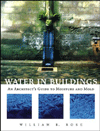The real answer? Never. As with most materials, concrete retains a certain amount of water when in equilibrium with the build environment.

The real answer? Never.
As with most materials, concrete retains a certain amount of water when in equilibrium with the build environment. However, concrete is a particularly wet material. Using ASTM #2170, the equilibrium relative humidity (ERH) test, most flooring manufacturer guidelines require the concrete maximum moisture to be between 70 and 75% ERH before placement of the floor will be warranted. Furthermore, 70 to 75% ERH is usually about 0.70 to 0.75 water activity. That makes concrete one of the wettest of our “dry” building materials.
As with any drying project, make sure you have identified the source of the water that has made the concrete too wet to apply flooring. Except for prolonged flooding, most water losses only cover the concrete with for as little as a few hours to as long as a day. This is seldom enough time for the water to penetrate the surface and saturate the concrete. Therefore, in most water losses, the moisture on the surface of the slab will usually evaporate in the time it takes to dry the structure - especially if the structure is timber framed.
If the slab shows that it is still too wet to place flooring after the rest of the building is brought back to its normal equilibrium, there is usually an underlying reason for the excess moisture. Reasons may include an insufficient moisture barrier under the slab, a water pipe or hydronic heating leak, garden sprinklers spraying on the building, etc. You must determine the original source of the water in order to prevent the problem from reoccurring.
Now, if the concrete has been tested, and it has been confirmed that it is too wet for the flooring by either moisture-vapor emission rates (MVER) or the ERH ASTM standards - and the source has been corrected - drying must be performed. Determine the goal specified by the flooring manufacturer and allow ample time for the project. Concrete takes weeks - not days - to dry. That’s the way it is – concrete absorbs water slowly and releases it even more slowly. Most flooring material standards are either 3 to 5-lbs of evaporation per 1000 square feet (MVER) or 70 to 75% (ERH).
Drying is best achieved with air dew points below 30ºF and constant low velocity airflow. Temperature is up for discussion. Several friends of mine like to heat the slab anywhere from 85 to 95ºF, raising the internal vapor pressure. Others point out that if you do not heat the slab thoroughly, you may drive moisture deeper into the concrete (note: cooler areas deeper in the concrete have lower vapor pressure compared to the hotter surface attracting some of the excess moisture) and then when the heated portion of the slab cools back down to 70 to 75ºF, the moisture “bounces” back to the surface, necessitating further drying and time loss. The main problem here is it is difficult to test concrete while you are drying at elevated temperatures.

Testing must be done according to ASTM standards (visit astm.org for downloadable standards). Clearance or verification should be provided by a third party testing firm. Find a competent one. Several years ago on a dry-out, the project manager called me yelling and screaming after a week of drying, saying we made the concrete even more wet! He indicated that the testing company (who was the flooring supplier that wanted to place a sealer on the floor instead of drying it) used the MVER (ASTM #1869) test on the floor while we were drying. The testing company said the slab was worse (or more wet) because we increased the evaporation rate from 11 to 16 lbs per 1000 square feet! I agreed that the evaporation increased and told him that is how we dry materials - by evaporating the excess water! The MVER test is a poor indicator regarding moisture content of the concrete because it only measures the evaporation rate off the surface. This antiquated test is truly outdated and often poorly applied as it is easily duped by variations in air temperature, humidity ratio and surface conditions of the concrete. The ERH test gives you a relative humidity target at a certain temperature, for instance, 75ºF. The ERH test is also not useful when drying at elevated temperatures because the relative humidity lowers as you heat the slab above 75ºF. Possibly, if you convert to dew point (a dry side target of 65% relative humidity at 70ºF is equal to 57.7ºF dew point), you may be able to monitor the slab at elevated temperatures using dew point. This may give you an idea of where you are heading in relation to your target before you cool down for confirmation testing.
As always, your job is to bring concrete back to normal equilibrium with its environment. I also advise you to read Howard Kanare’s book with the Portland Cement Association titled Concrete Floors and Moisture. Also, the World of Concrete Trade Show in Las Vegas is an eye-opening experience. As always, happy drying and see you in class!




Report Abusive Comment